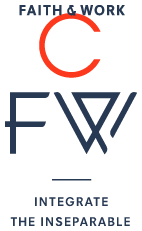
Blog
Aligning vision
and visuals
in the creative
process
By: Bethany Jenkins
Faith McCormick is a freelance art director in New York City. She attends Redeemer Presbyterian Church, where she was a Gotham Fellow through the Center for Faith & Work.
What does your work entail?
I work with all types of organizations—business, nonprofits, churches—to help them visually communicate their message, their mission, and their brand. When I work on a project with a client, it’s important that I understand who they are and what they are trying to say. So I do one-on-one meetings with them and ask them to fill out creative briefs that help me learn about their personality, audience, and goals. As we work together, we make decisions about font, color, texture, and all sorts of other things that will shape their brand.
Why does visual representation matter?
When an organization’s actual messaging isn’t aligned with its visual messaging, it’s confusing. Not only can it create uncertainty of vision, it can also result in a lack of user engagement. Last year, I worked with a client to create a cover for a book on prayer. We put so much effort into creating a proper hierarchy of text, discerning how certain textures evoked certain feelings, and choosing colors and typography that might create a sense of contemplation and peace. So much of art direction is about the end user—how something will detract or enhance his or her life.
Have you ever turned down working with a client for ethical reasons?
As an independent freelancer, I have a fair amount of freedom to choose my clients. But since most of my work is generated by word-of-mouth referrals, I haven’t yet been approached by a client with a questionable corporate philosophy. I have, however, worked with organizations and churches where I haven’t necessarily agreed with how they execute their vision. But I’ve served them. I’m not sure what I’d do, though, if a weapons manufacturer or a tobacco company—two industries that I personally disagree with—contacted me. I’d have to be discerning about where to draw the line.
What is the biggest challenge that you face as an art director?
As designers, we put so much of ourselves into our work, and we often think that we know what is best in absolute terms. But design is both objective and subjective. We have to listen to our clients and figure out what they truly need. I think some projects end up failing and intense emotions end up flying when the client and the designer aren’t communicating. Yes, art directors are experts in their field, but we work in a service capacity and, therefore, we must be good listeners. We need to cultivate a humble willingness to listen and adapt.
How do you think your Christian commitment affects your work?
Not only do I try to listen to my clients, I also try to work with integrity—not cutting corners on projects or overcharging just because I can. Being transparent about my process is important, too—being honest about timelines, apologizing for mistakes, and showing authenticity and grace. I’ve had times where I haven’t been paid or acknowledged for my work. Those have been difficult, but there are always injustices in life. I have to remember that I am called to work as unto the Lord and that he has promised to provide all my needs.
Bethany L. Jenkins is the director of TGC’s Every Square Inch and the founder of The Park Forum. She previously worked on Wall Street and on Capitol Hill. She received her JD from Columbia Law School and attends Redeemer Presbyterian Church in Manhattan, where she was a Gotham Fellow through the Center for Faith & Work.
This piece was originally published by The Gospel Coalition.
